Euphorbia is a diverse and widespread genus of flowering plants. They are sometimes referred to as spurge plants, because their leaves have a resemblance to the spurs of a plant.
The plants are native to various parts of the world, including Africa, Europe, and North and South America.
These plants have a distinctive appearance, with many species featuring unique and colorful flowers and foliage.
Euphorbia plants are also have a milky white sap, which is toxic to humans and animals if ingested. Despite this cautionary aspect, many Euphorbia species are good as ornamentals in gardens and landscaping.
Euphorbia plants come in different shapes, sizes and colors. Some could be small in size while others can grow to be very tall. The plants have very many uses and have been used by people for a long time.
They are easy to care for and can flourish in most climates. There are over 200 varieties of euphorbia available today to home gardeners who want some unique varies or something unusual in the garden next to their house.
Here I’ll break down some of the most popular types of Euphorbia plants, including their physical characteristics, habitat and uses along with how to grow them particularly if you’re in Europe, Australia or North America.
List of Euphorbia Plants
- EuphorbiaCotinifolia
- Euphorbia baioensis
- Euphorbia pulcherrima
- Euphorbia abyssinica
- Euphorbia tirucalli
- Euphorbia trigona
- Euphorbia lacteal
- Euphorbia milii
- Euphorbia amygdaloides
- Euphorbia myrsinites
- Euphorbia obesa
- Euphorbia polychrome
- Euphorbia mauritanica
- Euphorbia tithymaloides
- Euphorbia debilispina
- Euphorbia aphylla
- Euphorbia antiquorum
- Euphorbia vulcanorum
- Euphorbia geroldii
- Euphorbia ammak
- Euphorbia pseudoglobosa
- Euphorbia decaryi
Euphorbia abyssinica

- Common Name: Desert Candle, Candlelabra spurge or Euphorbia abyssinica
- Native Area: Ethiopia, Sudan, Somalia (Eastern Africa)
- Size: 4 to 10 feet
- Flowers: Yellowish
Euphorbia abyssinica also known as the Abyssinian euphorbia is native to the eastern Africa region, where it can be found growing in habitats such semi-arid lands, grasslands and rocky slopes.
It was first described in 1791, by the German botanist Johann Friedrich Gmelin. It’s a large succulent or upright tree-like plant which either grows singly or form candelabra-like clumps.
The main stem becomes woody as it ages, and sends out green side branches; these have between five and eight ribs or angles and branch at intervals.
Euphorbia abyssinica can reach up to 10 feet or more in height and produces small, yellow flowers that are surrounded by showy, bract-like structures.
The plant is very much easy to care for and it can be used as an ornamental plant in gardens, as well as a hedge or screen plant in landscaping.
Euphorbia Cotinifolia
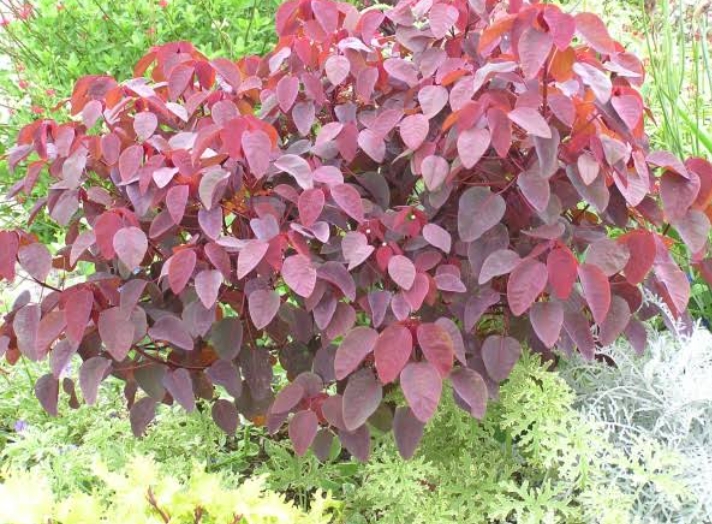
- Common Name: Smoketree spurge, Tropical smoke bush, Caribbean copper plant or narrowleaf spurge
- Native Area: Ethiopia, Sudan, Somalia (Eastern Africa)
- Size: 4 to 10 feet
Euphorbia cotinifolia, also known as narrowleaf spurge or Caribbean copper plant is native to Mexico, Central America and the Caribbean, though it has been introduced to other parts of the world as an ornamental plant.
This plant is generally a multi-stemmed shrub or small tree in nature and grows to a height of between 4 and 10 feet tall. It also features, lance-shaped leaves that are pink red in color.
Flowering occurs in late spring to mid-summer and while the tiny flowers at branch tips are not showy, the small cream to pale yellow bracts stand out attractively out against the red foliage.
The plant also features attractive purplish stems or rather a copper-colored bark, which gives it its common name, the Caribbean copper plant.
The purplish stems, when broken, exude a sap that is a skin irritant. The plant can be invasive in some areas due to its ability to spread aggressively through its seeds, which can be dispersed by wind or animals.
Also Read: Plants That Look Like Vagina
Euphorbia baioensis
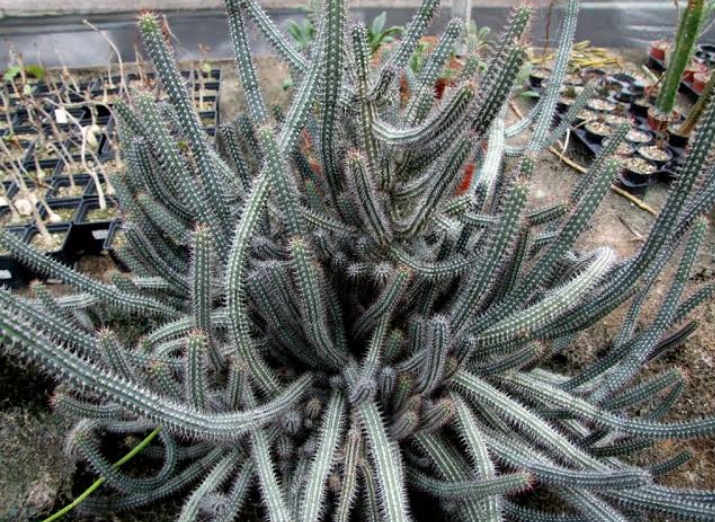
- Common Name: Desert Candle, Candlelabra spurge or Euphorbia abyssinica
- Native Area: Kenya
- Size: 4 to 10 feet
Euphorbia baioensis is native to Kenya and it can be found in tropical deserts and flourishes in hot dry conditions.
It is a compact succulent shrub growing between 4 and 8 feet tall with greyish-green cylindrical stems. The plant is mainly branched at the base and at maturity, it produces small, yellow flowers that are arranged in clusters at the end of the stem.
In many places such as United States or Europe, Euphorbia baioensis is loved by many gardeners for its distinctive, spiky appearance and you will find the plant growing ornamentally in containers.
The plant is considered to be a hardy and easy-to-grow plant, but it can be susceptible to certain pests and diseases such as aphids and root rot.
The plant has a fast growth rate and can be grown in different soil types, but it prefers well-draining soil and full sun to partial shade.
Euphorbia pulcherrima
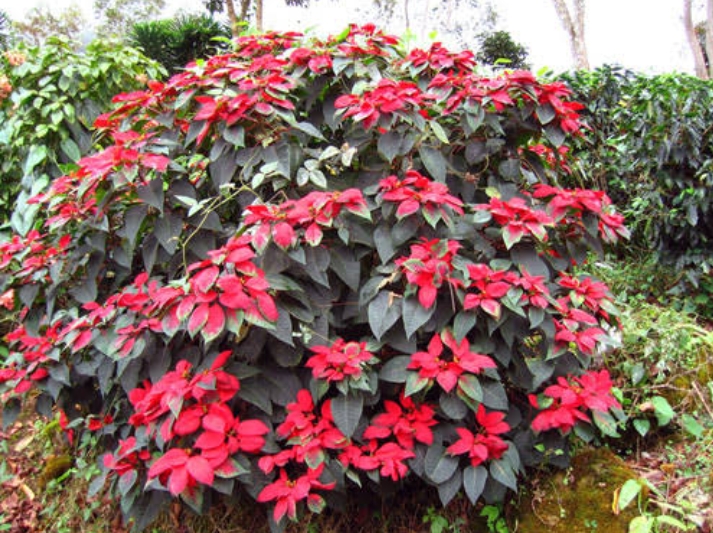
- Common Name: Poinsettia
- Other Names: Mexican flame flower” or “painted leaf”
- Native Area: Mexico and Central America
- Size: 2-6 feet tall
Euphorbia pulcherrima, also known as the poinsettia, is native to Mexico. It is most commonly associated with the Christmas season, as it is often used as a decorative plant during this time of year.
It has been grown for many years since 18th century. Prior to poinsettia, it was known as “Mexican flame flower” or “painted leaf”.
The flowers on this plant are small and yellow and are located in the center of the colorful bracts. The bracts are the modified leaves which if you aren’t keen you can mistake them for the plant’s flowers.
The bracts can be red, pink, or yellow in color and are what give the poinsettia its distinctive appearance.
Euphorbia tirucalli
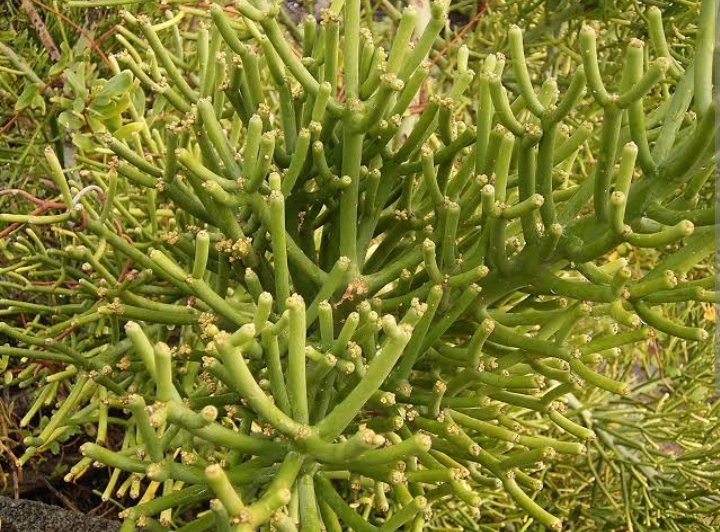
- Common Name: Milk bush, Indian tree spurge or Pencil cactus
- Native Area: East Africa and India
- Size: 4-12 feet tall
Euphorbia tirucalli, commonly known as pencil cactus, milk bush, or Indian tree spurge, is native to East Africa and India where it grows wilds in habitats such as savannas, woodlands and scrublands.
This succulent plant can reach heights of up to 12 feet or even more. It has thin, cylindrical and fleshy stems with pencil-like branches that are green when young but turn brown with age.
The plant has small, pale green or yellow flowers that are produced in clusters. Euphorbia tirucalli has ability to tolerate drought and heat, and grows best in well-draining soil with plenty of sunlight. It requires minimal watering and is generally low-maintenance.
Euphorbia trigona
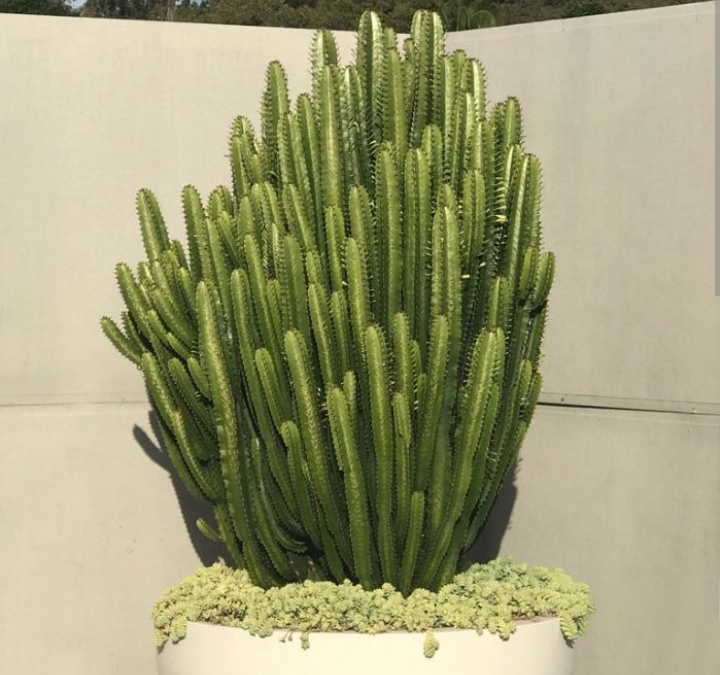
- Common Name: African milk tree or the cathedral cactus
- Native Area: Central and West Africa
- Size: 3-6 feet tall
Euphorbia trigona, also known as the African milk tree or the cathedral cactus, is native to Central and West Africa where it is particularly adapted to growing in arid environment.
It is a fast-growing plant that can reach up to 6 feet tall. It is characterized by an upright, columnar growth habit, with triangular-shaped stems that are covered in small thorns.
The drop-shaped leaves on the plant are glossy, dark green and arranged in a spiral pattern along the stems. The plant has never been known to flower and is possibly a hybrid.
When grown as a houseplant, Euphorbia trigona should be placed in a location with bright, indirect light and watered sparingly, allowing the soil to dry out completely between watering.
Also Read: Types of Naked Lady Flowers
Euphorbia lacteal
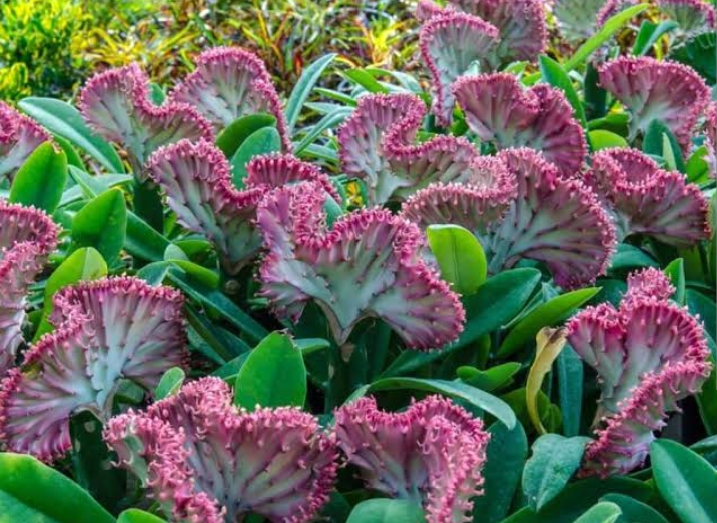
- Common Name: Dragon bones, hatrack cactus, milkstripe euphorbia or mottled candlestick
- Native Area: Europe
- Size: 2-4 feet tall
Euphorbia lacteal, also known as the milky spurge or the white euphorbia is native to Europe and is widely cultivated as an ornamental plant in gardens and parks.
The plant in general grows to be about 2 to 4 feet tall with upright, fan-shaped stems that are green and hairy when the plant is young, but become woody and brown as the plant matures.
The stems are thick and can be slightly curved or twisted. They also feature clusters of green, leaves that are arranged in an alternating pattern along the stem.
You can use this plant in mass plantings or as a border plant or pair it with other flowering plants to create a colorful, eye-catching display.
Euphorbia milii
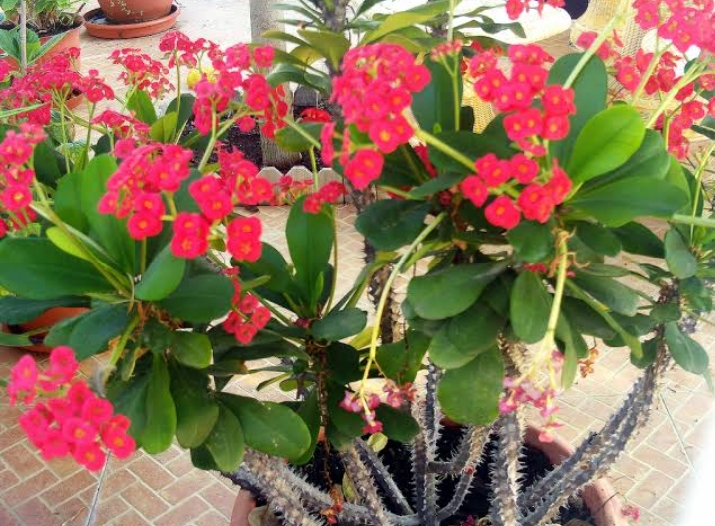
- Common Name: Crown of thorns or Christ plant
- Native Area: Madagascar
- Size: 4-10 feet tall
Euphorbia milii commonly known as crown of thorns or Christ plant, is native to Madagascar, but has been widely cultivated and naturalized in many other parts of the world, including parts of Asia, Africa, and the Americas.
The plant is named after Baron Milius, a French naturalist who first described it in the 19th century. The common name is due to the thorns and deep red bracts referring to the crown thorn Jesus had to wear during his crucifixion and his blood.
What you need to know about this plant is that, it’s a shrub or small tree and reaches heights of between 4 and 10 feet. Its spiny branches are grey-green whereas its fleshy leaves are visibly green in color.
The flowers are small and are surrounded by bright, colorful bracts. The flowers are usually red or pink but can still be white or yellow.
This plant is known for its ability to produce new growth from old wood, so it can continue to produce new stems and leaves even after the plant has become overgrown or leggy.
Euphorbia amygdaloides
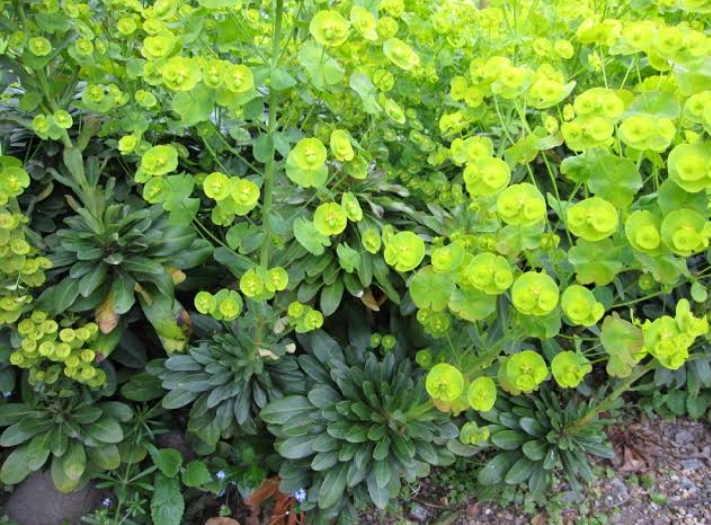
- Common Name: Wood spurge or Almond spurge
- Native Area: Asia and Europe
- Size: 13-25 inches
Euphorbia amygdaloides, also known as wood spurge or almond spurge, is perennial in nature and is native to Europe and Asia.
It is characterized by clusters of small, green-yellow flowers and shiny, dark green leaves that look like those of an almond tree.
The plant grows to a height of between 13 to 25 inches and has a sprawling growth pattern, with a clump-forming habit. The plant is hardy and can withstand frost and cold temperatures.
Euphorbia myrsinites
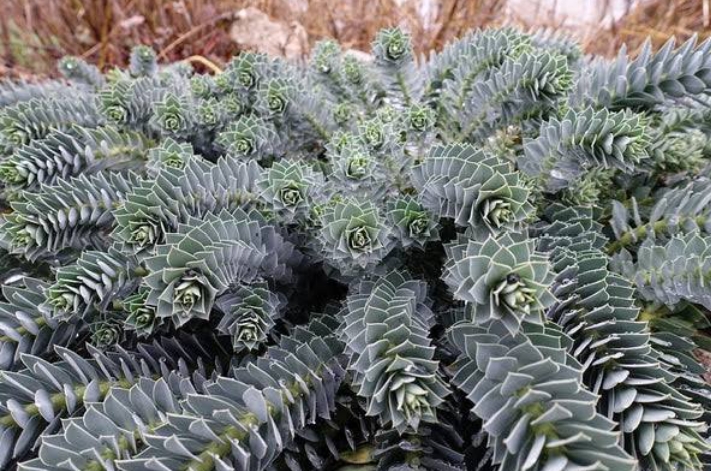
- Common Name: Donkey tail spurge or Myrtle spurge
- Native Area: Asia and Europe
- Size: 6-12 inches (15-30 cm)
Euphorbia myrsinites, also known as donkey tail spurge or myrtle spurge, is a low-growing, succulent plant that is native to the Mediterranean region.
When you pay a close look at this plant it has blue-green leaves that grow in a spiral pattern along thin, trailing stems.
It produces small, yellow flowers in the spring and summer months. Due to its sprawling growth habit and ability to grow in rocky or gravelly soils, it can be used as an ornamental plant in gardens or as a ground cover in dry, sunny areas such as Arizona, Kansas, Kentucky or Mississippi.
Euphorbia obesa
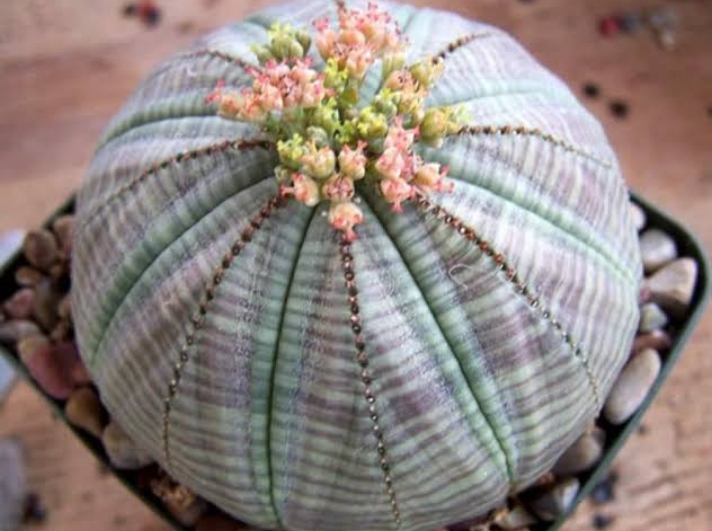
- Common Name: Baseball plant or baseball euphorbia
- Native Area: South Africa
- Size: 6-10 inches
Euphorbia obesa, commonly known as the baseball plant or baseball euphorbia, is a small ball-shaped succulent plant native to South Africa.
The plant reaches heights of between 6 to 10 inches whereas its stem grey-green and marked with horizontal brown red bands.
The plant’s surface is smooth and green or gray-green in color with small, white or yellow flowers at the top, that bloom in the summer.
The tiny leaves, fall off immediately after appearing. Euphorbia obesa is not a commonly encountered plant as it is not widely cultivated, but it can be found in specialty plant stores or online.
Also Read: Types of Yellow Lilies
Euphorbia polychrome

- Common Name: Cushion spurge or cushion euphorbia
- Native Area: Western United States
- Size: 12-24 inches
Euphorbia polychrome, also known as cushion spurge or cushion euphorbia, low-growing plant that’s native to the western United States where its commonly found in rocky slopes and open woodlands.
It grows to heights of between 12 and 24 inches with an almost equal spread. During its growth phase, it forms a neat, cushion-like mound of thick, succulent-like leaves which appear narrow and lance-shaped with glossy green color.
In the spring, throughout summer, Euphorbia polychrome produces clusters of small, cup-shaped flowers that are surrounded by colorful bracts. The flowers are often yellow, but can also be orange or bright yellow-green.
Euphorbia mauritanica
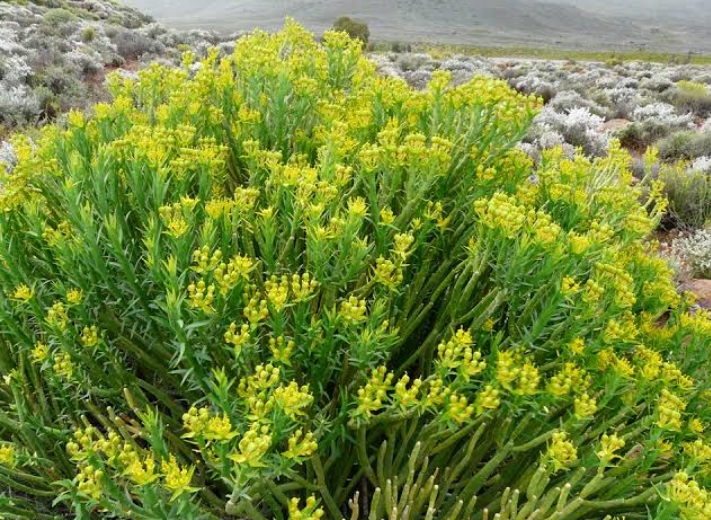
- Common Name: Mediterranean spurge or Moroccan spurge
- Native Area: Western Mediterranean region
- Size: 1 to 2 feet tall
Euphorbia mauritanica, also known as the Mediterranean spurge or Moroccan spurge, is a perennial in nature and native to Mauritania, Morocco and the western Mediterranean region.
It grows to be about 1 to 2 feet tall at maturity. The plant has slender, upright stems that are covered in small, spiky leaves.
Due to its sprawling or spreading growth habit, it can form dense mats of foliage over time. It produces small, bright yellow flowers in spring and summer, which are followed by small, spiny seed pods.
The plant is also resilient and tolerant to drought, and can thrive in dry, rocky soil. It is also resistant to deer and rabbits.
Euphorbia tithymaloides
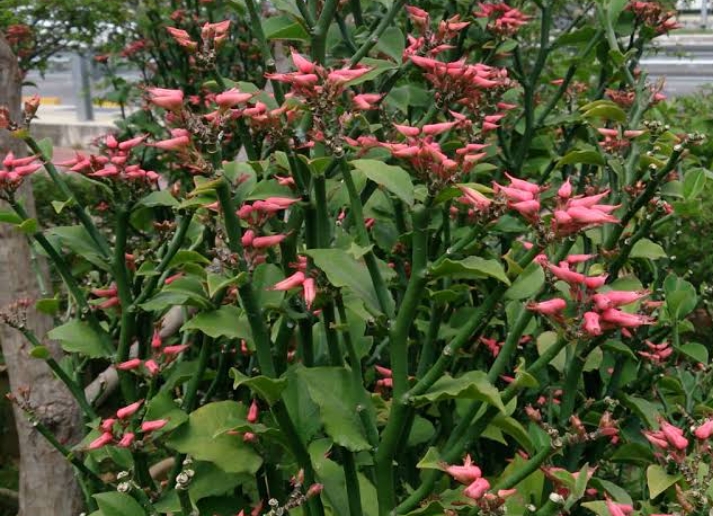
- Common Name: Devil’s Backbone or Christ Plant
- Native Area: Mexico and Central America
- Size: 2-3 feet tall
Euphorbia tithymaloides, also known as Devil’s Backbone or Christ Plant, is a perennial succulent plant native to Mexico and Central America.
It has jointed, green stems that grow upright, forming a clump or mound-like shape. The stems are often adorned with large, dull green leaves that are arranged irregularly or alternately along the length of the stem. The plant grows slowly and can reach heights of up to 2 to 3 feet when mature.
It grows in a spreading form and can create colonies over time through the production of offsets or small plantlets that grow from the base of the main plant.
Euphorbia tithymaloides is a versatile plant that can be grown in a variety of settings, including gardens, containers, and in landscaping as a groundcover or border plant. The flowers are usually red or pink.
Euphorbia debilispina
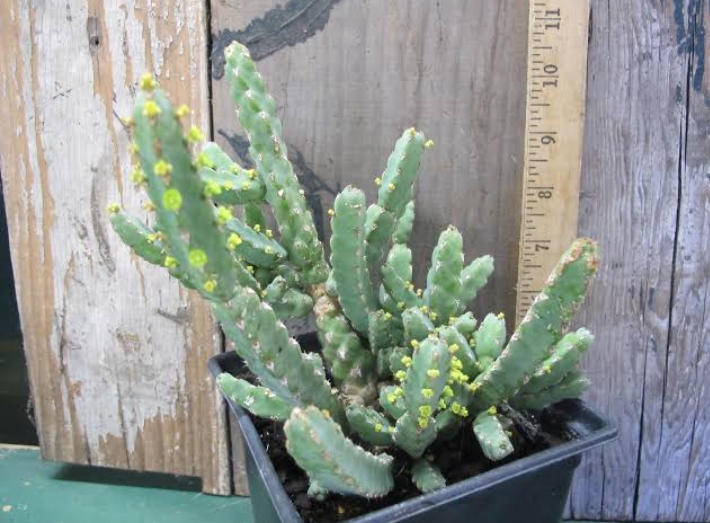
- Common Name: Debilispina euphorbia
- Native Area: Namibia and South Africa
- Size: 12-24 inches
Euphorbia debilispina is for sure a rare type of Euphorbia that’s native to Namibia and South Africa.
It can grow to a height of about 12 inches or more. It is characterized by sprawling or spreading growth habit with thick, branches that tend to bend or droop as the plant matures.
With time as the plant grows, new branches may emerge from the base of the plant or from the sides of existing branches.
Stems are simple or branched, 4-angled, and grey-green to blue-green with a reddish tinge in full sun. The flowers are often small, yellow in color and arranged in clusters along the branches.
This plant can grow excellently in garden spaces or arrangements where it will not be overshadowed by taller plants.
Euphorbia aphylla
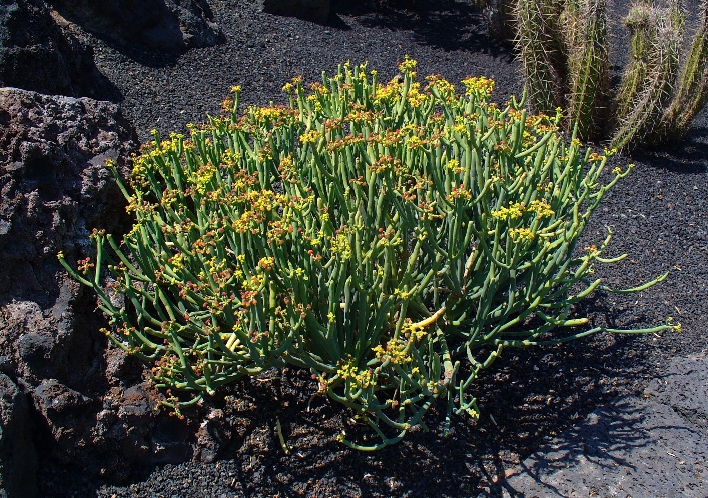
- Common Name: Aphylla euphorbia
- Native Area: Canary Islands
- Size: 12-24 inches
Euphorbia aphylla is a small shrub-like plant native to Canary Island characterized by a woody base, thin, wiry stems and a somewhat open, airy appearance.
In other words, it is densely branched with a short brownish corky trunk and pencil-like green stems that branch in whorls.
It grows to approximately 20 inches tall at maturity, although the size can somewhat vary depending on growing conditions.
Euphorbia aphylla is sometimes called a leafless spurge because the leaves are often reduced in size or absent altogether, especially on older plants or in dry conditions.
The plant produces small, yellow flowers that are arranged in clusters at the ends of the branches. The flowers are followed by small, three-lobed capsules that contain the seeds.
Euphorbia antiquorum
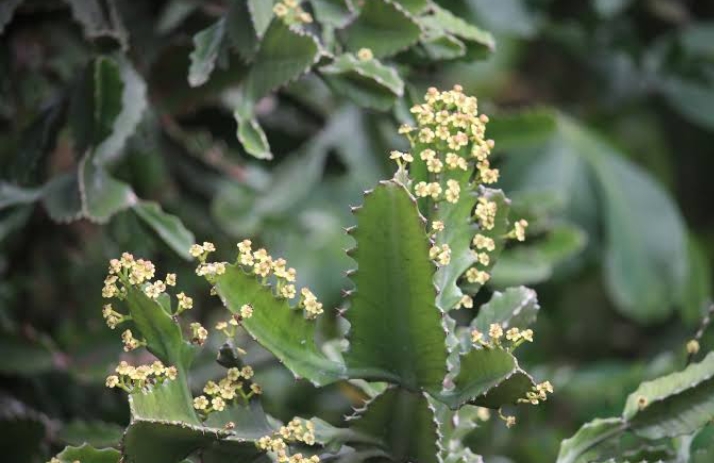
- Common Name: Antiquorum euphorbia
- Native Area: Arabian Peninsula and Somalia
- Size: 3-15 feet tall
Euphorbia antiquorum is a small plant with ascending branches and grows to somewhere around 15 feet or more in height at maturity.
It is native to the Arabian Peninsula and Somalia and is also known by several other common names, including ” Square spurge,” and “antique spurge.” These names refer to the plant’s appearance, which is characterized by its small size, spiny stems, and flowers.
The flowers are small and inconspicuous, and are surrounded by showy, yellow bracts. The leaves of the plant are small and scale-like, and are found clustered either at the base or apex of the stems.
Because of its size and the bright green stems, you can use the plant in a front or backyard rock garden.
Euphorbia vulcanorum
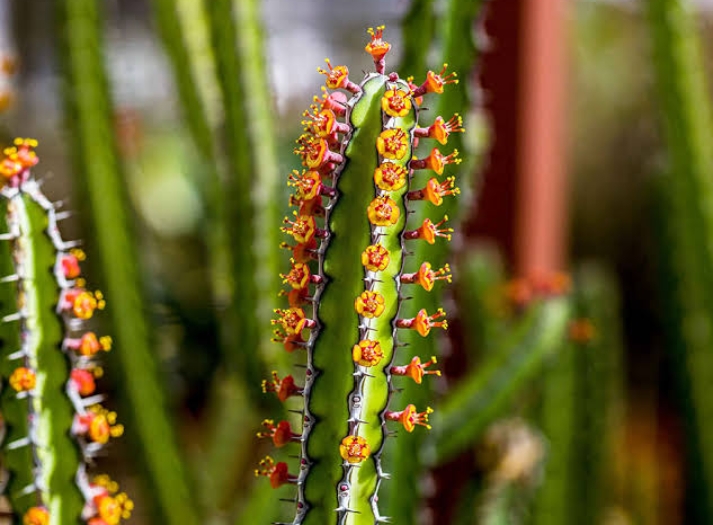
- Common Name: Vulcanorum euphorbia
- Native Area: Canary Island
- Size: 2-4 feet
Euphorbia vulcanorum is a small plant which grows to be about 2 feet or more in height at maturity. The species is named for its occurrence on the volcanic island and for the fact that it is occasionally found growing on rocky, volcanic soil.
It is features 4 angled branches attractively marked with spines along the margins. The leaves are greenish in color but fall off immediately they appear.
It is native to the island of Tenerife in the Canary Islands, where it is found at high elevations on the slopes of Mount Teide, an active volcano.
It is a uncommon plant and is not widely cultivated outside of its native range in the Canary Islands. Flowers are small and particularly showy in shades of red or orange appearing mainly during spring to fall.
Euphorbia geroldii
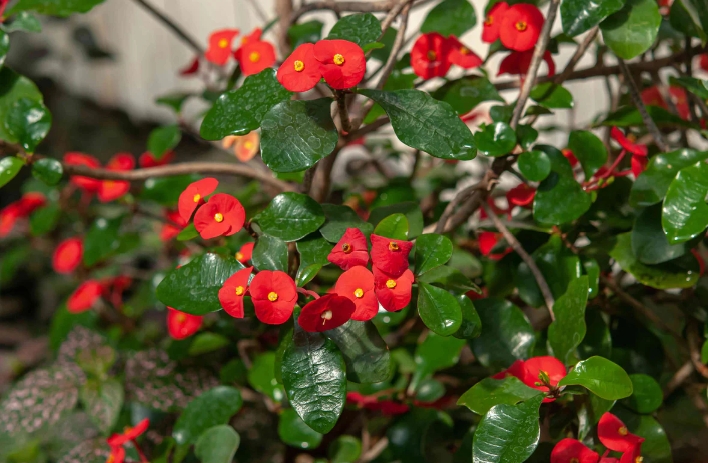
- Common Name: Gerold’s spurge or Thornless euphorbia
- Native Area: South Africa
- Size: 2-3 meters tall
Euphorbia geroldii is also known by the common name “Gerold’s spurge.” It is sometimes called Thornless euphorbia or spurge. Its native range includes the Mediterranean region, Madagascar and South Africa.
The plant has bushy, upright growth habit and produces branches both from the base and at the top. It also has dark green leaves that are somehow elongated. Unlike its cousin euphorbia milli, it doesn’t have thorns.
The plant also produces pink-red flowers with yellow centers at the ends of the branches. The plant is always in constant bloom and grows to about 3 meters tall and can spread to about 1.5 meters wide.
It can be grown as a standalone specimen plant or used in group plantings in your garden.Top of Form
Euphorbia pseudoglobosa
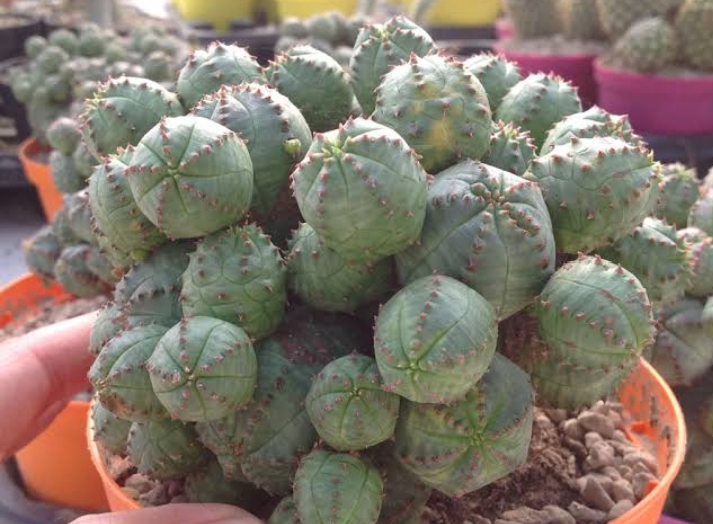
- Common Name: False globose spurge
- Native Area: South Africa
- Size: 6-12 inches tall
Euphorbia pseudoglobosa also referred to as false globose spurge is a dwarf, low-growing succulent plant that forms a mat of gray-green segmented stems.
The plant produces clusters of small, unisexual, solitary, yellow flowers at the tip of the segments. The plant is native to South Africa and grows in rocky, sandy soils, which may contribute to its appearance.
It is suitable for growing in a variety of climates, including warm temperate, subtropical, and tropical regions.